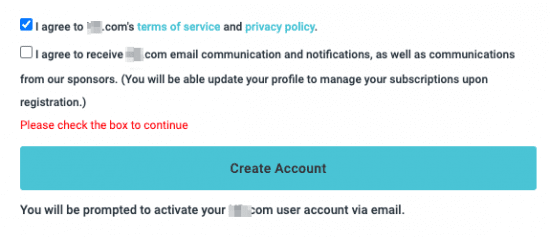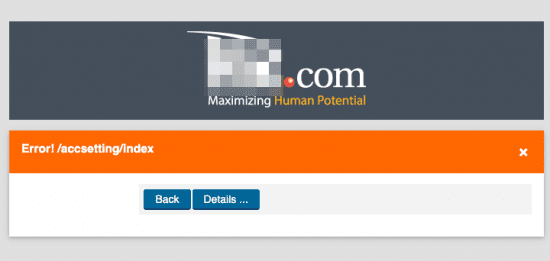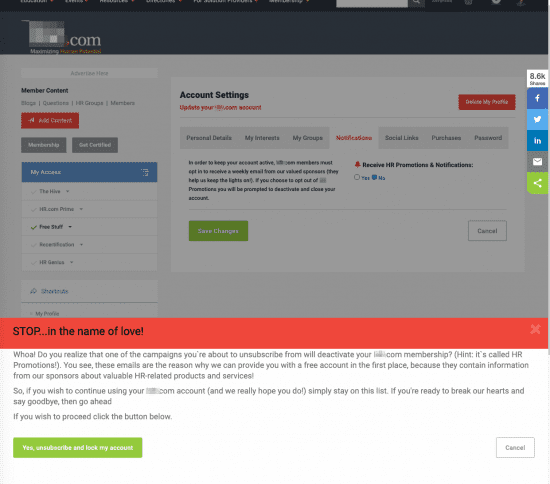After a spate of emails from a fairly large portal site (it’s ranked around 50,000th on Alexa worldwide), I was appalled at the number of marketing sins they have committed. Either this organization is doing so intentionally, which is borderline unethical, or the leaders are unaware, in which case it’s pure incompetence. Ironically (as far as I’m concerned), they promote that they are the “most trusted resource” for their industry (human resources).
Just because it’s digital doesn’t mean you can remove the human element.
@mdial
Herewith are the seven digital marketing sins this site has committed. No one is perfect, but are you doing any of these too? At the bottom of this article, I list a few actionable points you can take as a leader of an organization managing a digital marketing presence.
1/ Slow site – long load time

I know that my own site is dismally slow to load up, so this might seem a bit hypocritical. But (a) I’m actively working on it and (b) I’m not a large organization using agencies and employing several hundred people. As a first impression, it’s not a good start.
2/ Forced email opt-in at sign-up
In a rather leonine manner, when you sign up for access to the site (it’s free), they ask you to check two boxes after completing your name and email address. Neither is optional.

I would suggest changing the wording to the second phrase to:
“As a condition of becoming a member, I agree to receive email communications and notifications…” But, when you try to update your profile to unsubscribe, you are booted out. Hum!
3/ Immediate pop up
Once you log in, they immediately have a large pop up disturb you. As a second impression, this gives off the impression that you are clearly quite pushy.
4/ Almost desperate social media…
With the scale and presence of this site, you would imagine that a “most trusted resource” would have large amounts of engagement and sharing for their content. In a classic case of, what I consider, “grabbing” followers, their Twitter account is following several thousand more accounts than it has followers. Where they have nearly 100,000 followers, their tweets garner 0 to 1 likes on average, which is anaemic. On Facebook, most of their posts seemed to receive between 0 to 2 likes. In the good news column, they aren’t liking their own posts. And their LinkedIn presence is decidedly more robust and useful, I’d say, although all their content is behind a membership wall.
5/ Creepy crawly and BUGGY
When I went to fill in my profile, the site rejected my entries without explanation, including sending this inexplicable error message:

So much for a good user experience.
6/ Unsubscribe… over my dead body
Being subscribed to their email newsletter is the sine qua non of being a member on this site. They explain it clearly that they get their money through sponsors of their email. Getting your business model right is difficult, but making membership conditional like that feels more like a menace that an organization bent on providing you with you value. As a result, they do not have an unsubscribe button on their salesy emails. And, when I went to unsubscribe on their site, this is the message that pops up:

7/ Wrong form of transparency?
Getting the business model right is far from easy. There aren’t many options and there are no good shortcuts. Building up a loyal following that trusts your content takes time. Playing at the game of “ensnaring” its members is hardly a road to building trust. While they do say as much within their site, they don’t make it clear at the outset. In a tab at the bottom of their site, they have a “Do not sell my data” link that formally states:
“In order for [our site] to no longer share your personal information with third-parties, you will no longer comply with the Terms of Agreement of our website, which will result in the deletion of your account with [us].”
Unfortunately, I personally don’t see enough value from their site. Then again, I’m not part of their target market (which they make patently clear when I sign up, by giving people only two options). If their content were so valuable with their target market, meanwhile, I would have expected to see considerable social proof.
Bottom line(s)
I am left to wonder about the ethics of this organization and their governance model. I wonder if they have a board that is aware of these practices? I don’t have any further insights into their objectives and client base, but I am doubtful about the sustainability and loyalty of their sponsors. It may be working for now, but I believe it’s a suspect route to follow. Herewith a few takeaways for anyone in leadership position that is overseeing a digital presence and strategy.
Do your own investigation
As a leader, you need to be entirely eyes-wide-open about how your digital team is operating. A good first step is to keep going on to your site from different computers (including a smartphone) that won’t recognize your identity and see how it is to be in a potential customer’s shoes. For more specific instructions: clear cache and use a browser you don’t use customarily.
Just because it’s legal doesn’t make it good
Ethics are personal. Are you treating your customers (members and sponsors) in ways that you’d like to be treated? Do you treat your employees in a way that is in line with the way you want to treat your customers? I’ve seen many companies where they have to over-compensate their employees because they know of the lines they are asking their employees to cross. When you set up your site, consider making explicit your ethical framework, at least to your teams and agencies. Bringing your ethical backbone is all the more important if you’re considering automating your processes and/or adding artificial intelligence into the mix.
Make sure your video is aligned with your audio
If you want to be trustworthy, you need to act in a trustworthy manner. It’s best to show it rather than tell it. How do you measure your trustworthiness? How do express it? In short, especially if the name of your game is the email list, how do you operate in a way that says:
“Oh my gosh. I’m so excited to open up this email. And, furthermore, I can’t wait to receive the next one!”
How do you measure success?
Many online businesses will tend to focus on the money-related KPIs such as cost per click, open and conversion rates. When looking at open rates (e.g. say, 18%), that means that you are not getting through to 82%. And, more poignantly, there’s a good chance that you are pissing off a good proportion of that 82%. What you should also be evaluating is how you are showing up in alignment with your brand and your promise. If trustworthiness is a key concept, how are you measuring it?
If you want to create a company with an enduring business model with engaged employees, you’ll need to think carefully about your ethics, lead by example and walk the talk. Being karmic is the golden dust you need to sprinkle on your process, people and presence. And that means having good intentions and congruent actions. Give value and let people come to you rather than hijack your customers and make them feel commanded and controlled.
So, how do you stack up? Do you agree that these are cardinal digital marketing sins?
***If you like my writing and are interested in fostering more meaningful conversations in our society, please check out my Dialogos Substack. This newsletter will feature articles on why and how we can all improve our conversations, whether it’s at home, with friends, in society at large or at work. Subscription is free, but if you see value in it, you are welcome to contribute both materially and through your comments. Sign up here:











